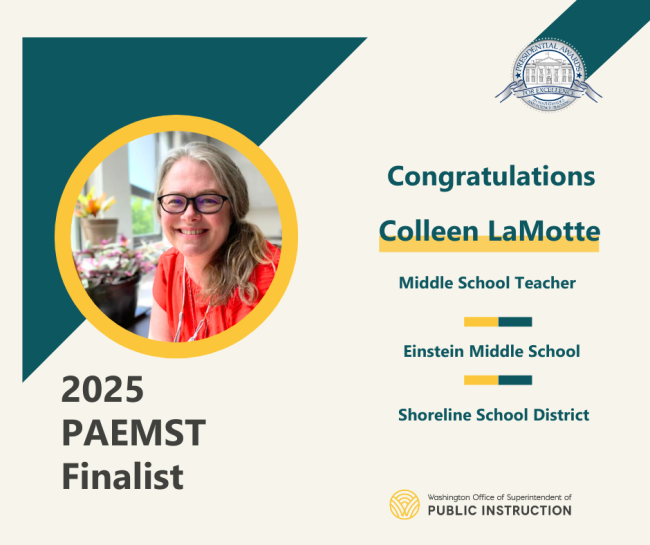Colleen LaMotte
Media Contact
Katy Payne she/her
360-764-0201

What has been your personal journey on the way to excellence in teaching math/science?
As a learner, I always wanted to understand why—not just memorize answers. That same curiosity drives my teaching: I want students to make sense of science, not just perform it. Over the years, I've shifted from delivering content to designing experiences that center student thinking, evidence-based reasoning, and productive struggle. Collaborating with colleagues, engaging in professional learning, and listening deeply to students have all shaped my practice. I've also worked to ensure every student sees themselves as capable of scientific thinking—especially those historically marginalized in STEM. Excellence, for me, is not about perfection, but about continuously refining my practice to support all students in becoming confident, critical thinkers.
What is one concept that excites your students and why?
My students are deeply curious about the world around them, and what excites them most is the chance to lift the veil on science—transforming their surroundings from something mysterious into something predictable, solvable, and within their reach. Whether they're exploring why some objects break in collisions while others bounce, how invisible magnetic forces work, or how traits are passed down through generations, students feel empowered when they can figure things out for themselves.
How do your lesson planning and teaching practices engage and support all students?
My lesson planning and teaching practices are grounded in the belief that all students bring diverse experiences, ways of thinking, and brilliance to the classroom—and that their ideas are essential to the learning process. I design lessons that position students as sense makers, not just receivers of information. Students engage in figuring out real phenomena, learning in community through structured talk, shared models, and opportunities to revise their thinking over time. This approach values multiple perspectives and supports different ways of expressing understanding. I build in time for noticing and wondering, which helps surface students' questions and connects science to their lives. I also use scaffolds, discussion routines, and formative assessment to ensure all students can access the work and grow from where they are.
How do the math and science concepts and skills you are teaching students help to prepare them for later learning, careers, and life?
The math and science concepts and skills I teach prepare students not only for future learning and careers, but for life. Scientific literacy is essential for making informed decisions—whether it's evaluating health claims, understanding environmental issues, or interpreting data in the news. But beyond content, students are learning how to think: to ask questions, analyze evidence, and reason through complex problems. These practices empower them to be critical consumers of information and active participants in their communities.
What can math and science teachers do to make those disciplines more culturally sustaining for students with diverse identities and experiences?
Math and science teachers can make these disciplines more culturally sustaining by recognizing and honoring the diverse identities, experiences, and ways of knowing that students bring to the classroom. Science and math are often seen as rigid or neutral, but in reality, they are human endeavors that thrive on creativity, curiosity, and collaboration. When we invite multiple perspectives and ways of thinking—including cultural, experiential, and historical knowledge—we enrich our understanding and become more likely to solve complex problems. I intentionally create space for students to share their own experiences and questions, connect science to their communities, and see themselves as valued contributors to knowledge-making.
What advice would you give to parents, families, or caregivers who want to support their students’ math and science learning?
I would encourage families to support their student’s math and science learning by nurturing curiosity at home. Ask them what they're wondering about, and invite them to explain their thinking—even if the answer isn't clear yet. Encourage them to take academic risks, explore ideas, and be okay with not knowing right away. One of the most powerful messages families can give is that learning is a process: it's okay to make mistakes, change your mind with new information, and keep trying.






